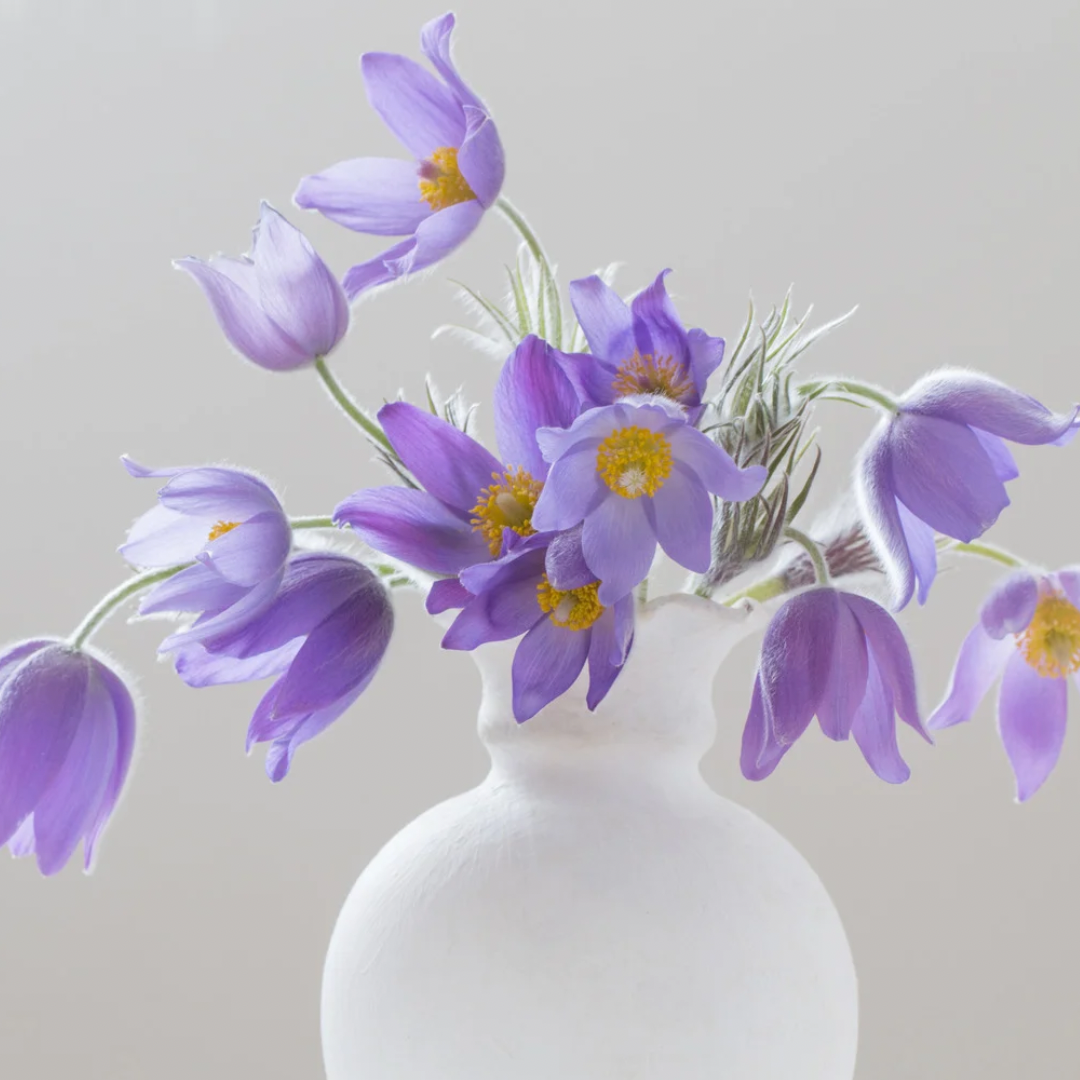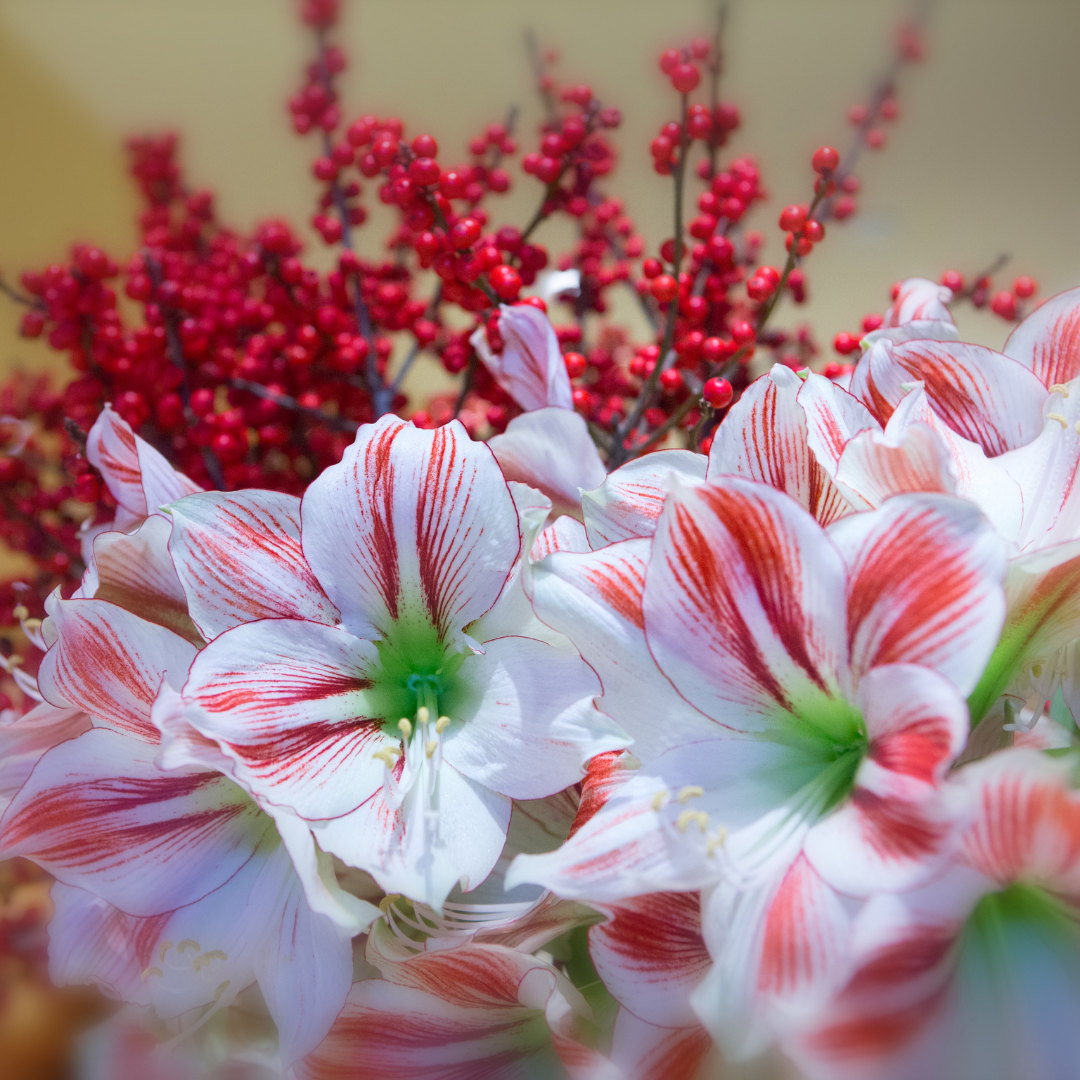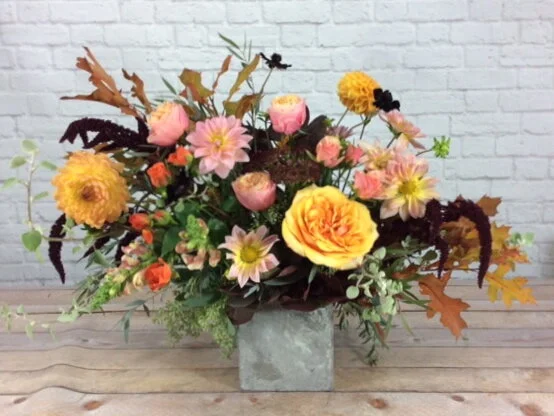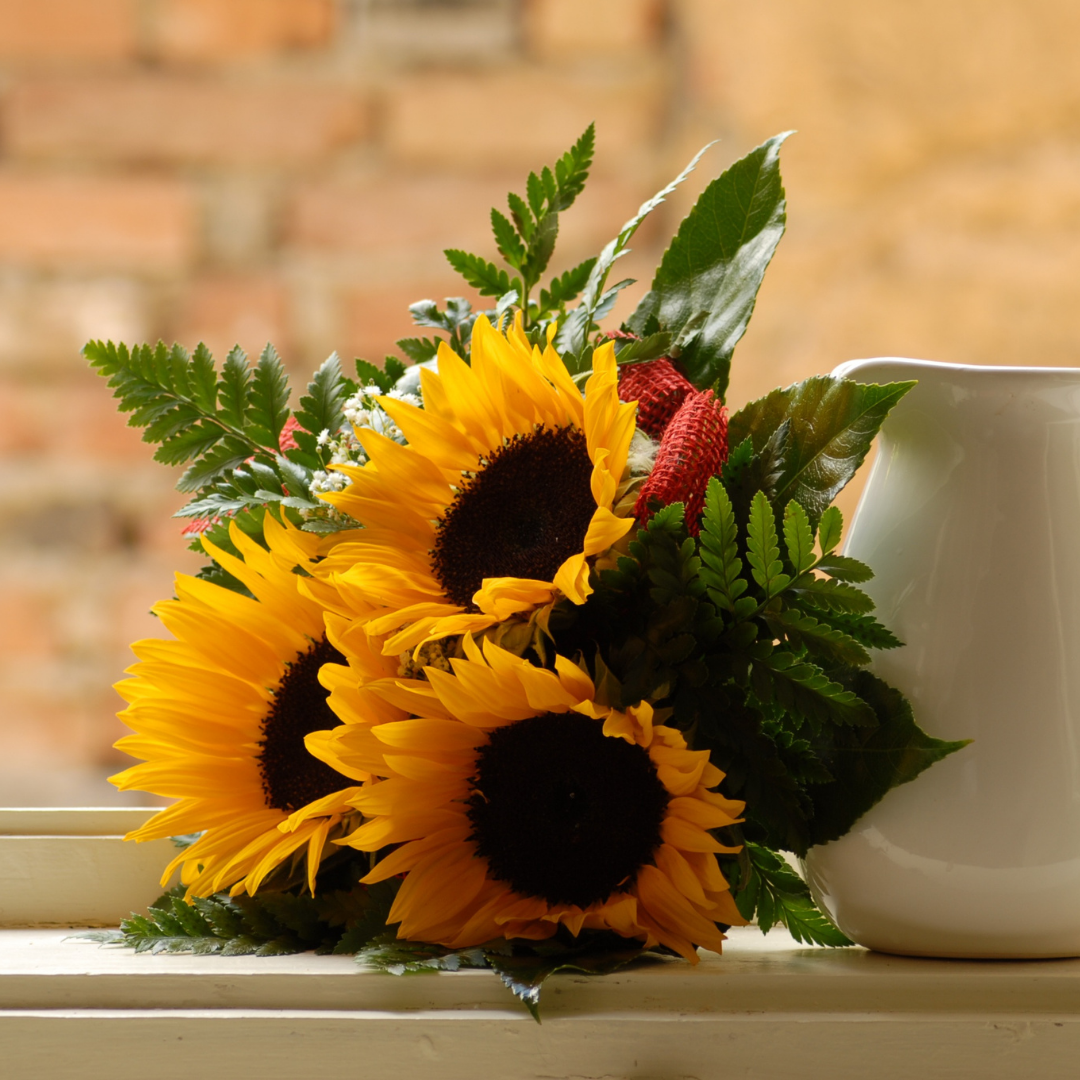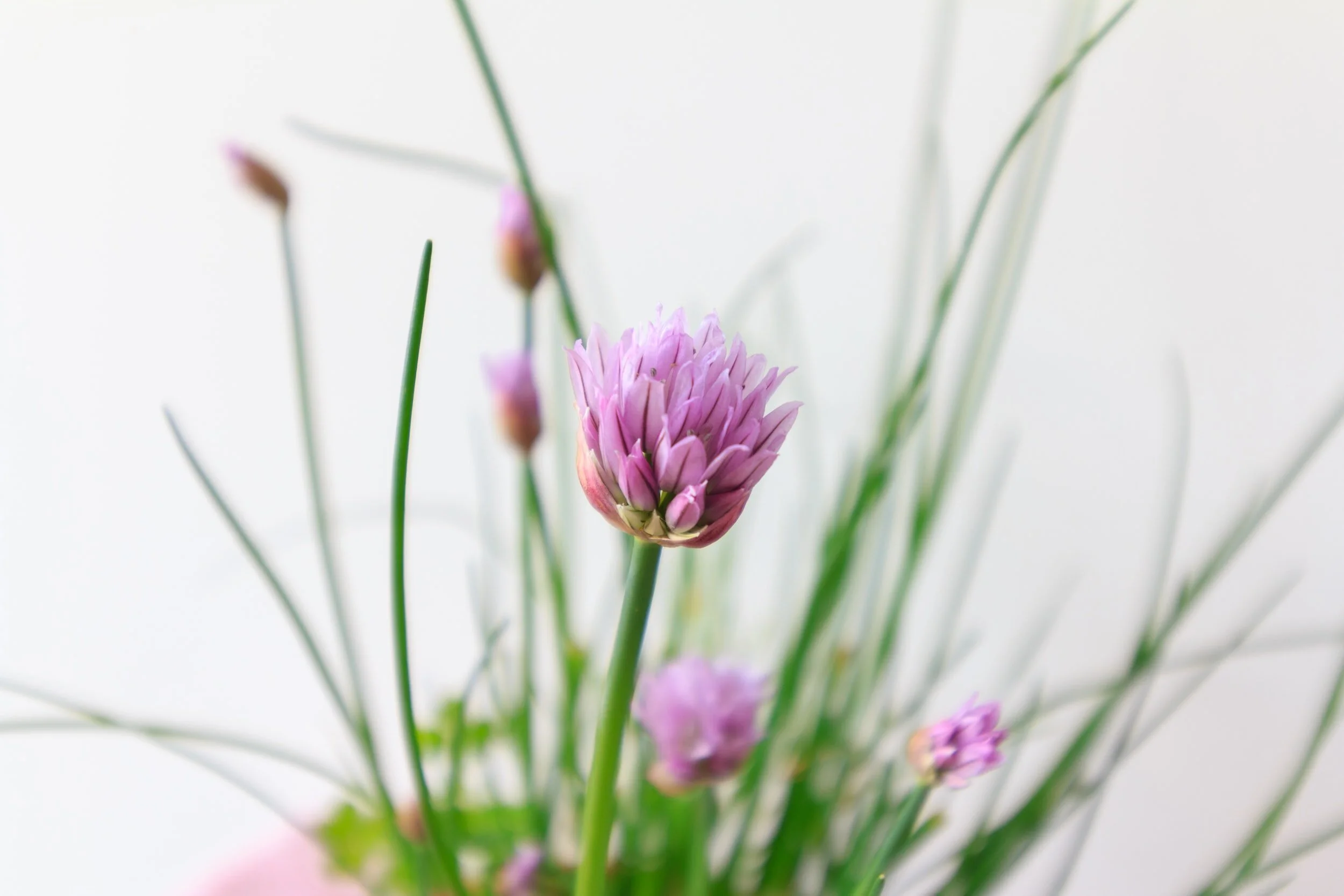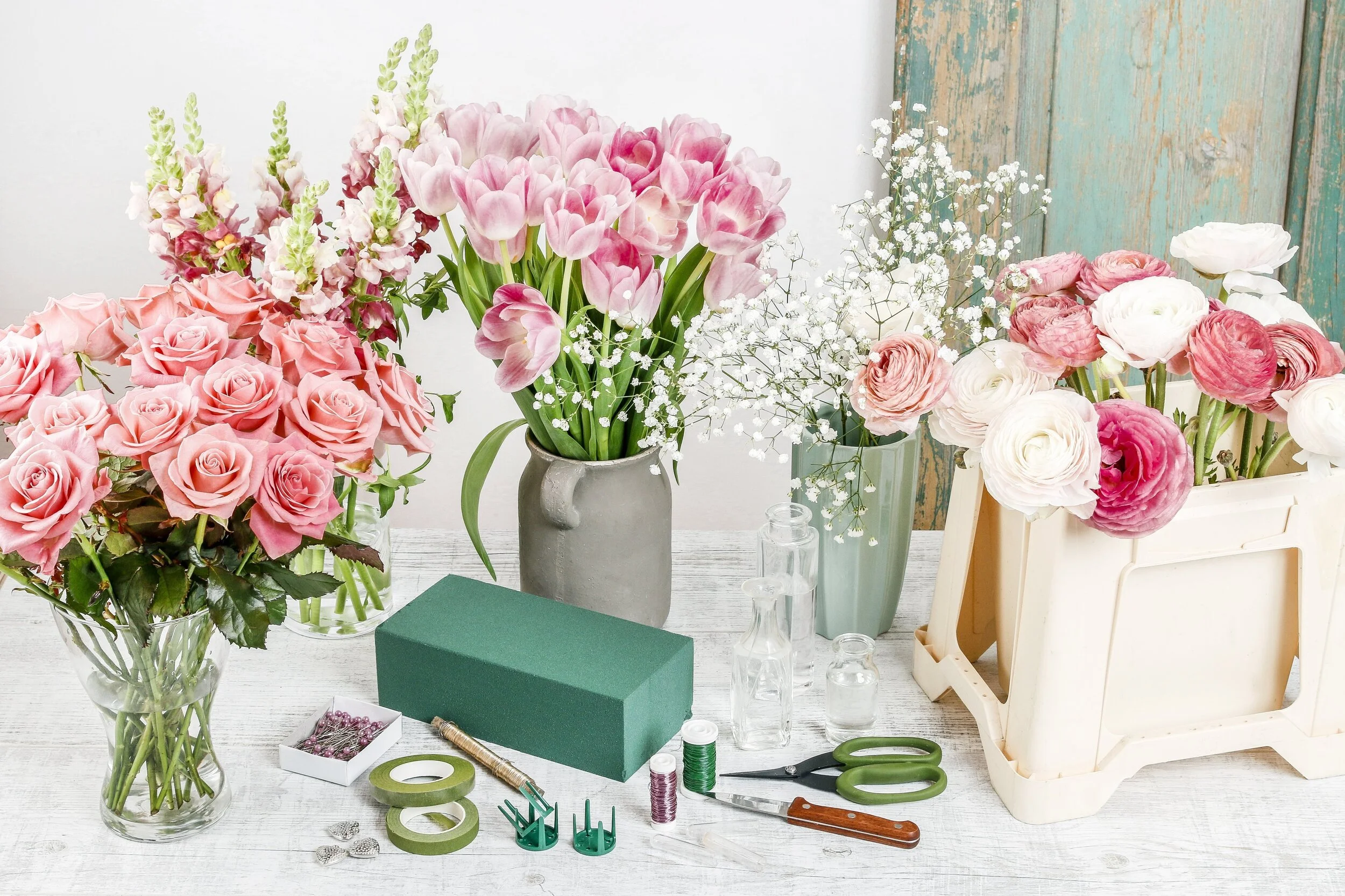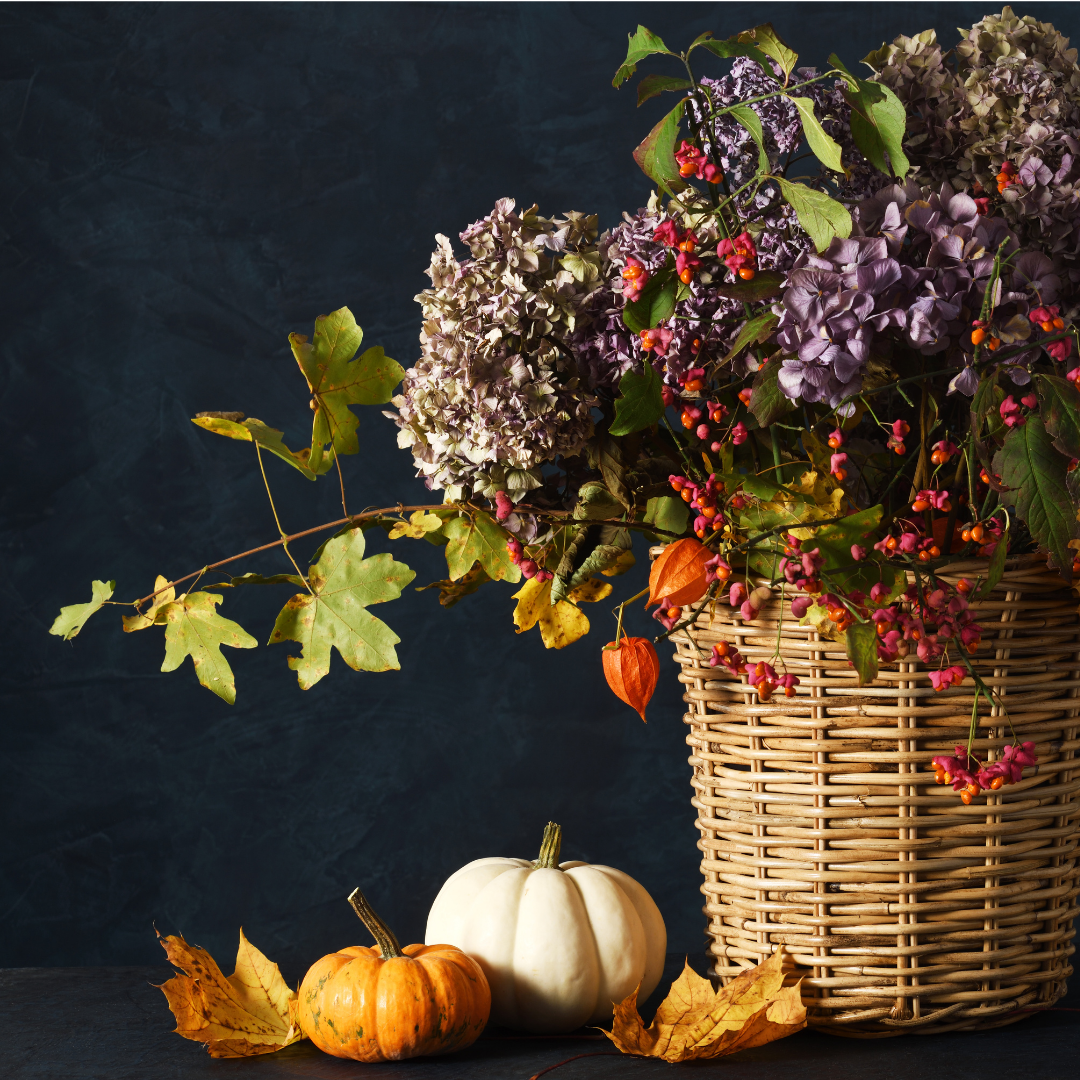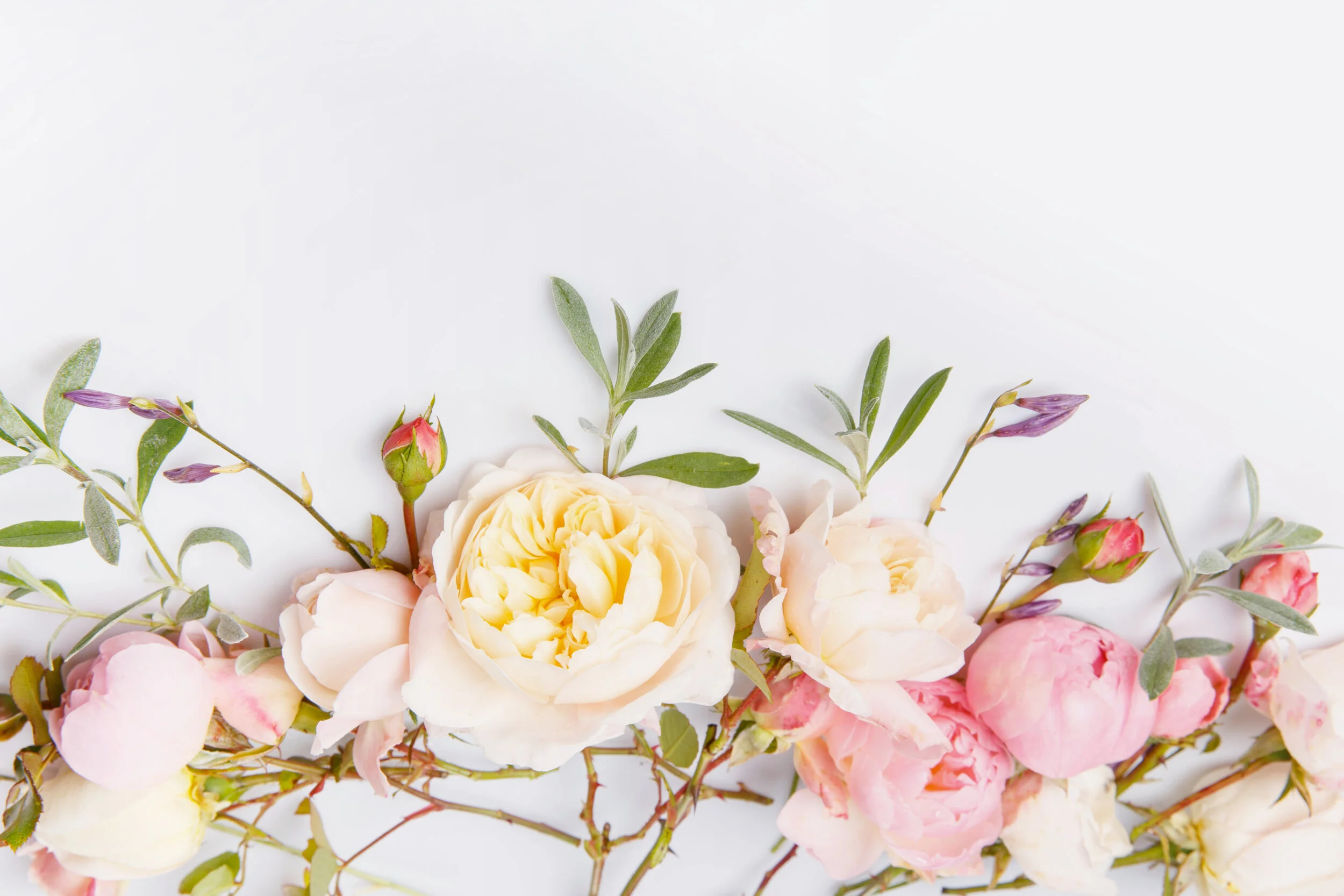4 Tips on how to Arrange Short-stemmed Flowers in a Tall Vase
My most popular blog post ever was ‘How to Arrange Short-stemmed Flowers in a Tall Vase’. Since that was a while ago I thought I would share my suggestions again.
Here’s what you can do when you have …
My most popular blog post ever was ‘How to Arrange Short-stemmed Flowers in a Tall Vase’. Since that was a while ago I thought I would share my suggestions again.
Here’s what you can do when you have a vase that is too tall for your short-stemmed flowers:
Tape a grid: Take some scotch tape and tape a criss-cross grid along the top of your vase. Make sure the holes you create are quite small. You want the stem of a flower to fit through the opening, but not slip all the way down. If the stems are very thin, you could put a few together into the same space. Make sure you keep the water level topped up using this technique as the stems won’t be reaching very far down into the vase.
Rule of thirds with a flower arrangement: In floral arranging, there’s the ‘rule of thirds’; the vase or container should be ⅓ of the total height of the arrangement and the flowers should be ⅔’s. This will create a balanced look. But, you can also do a ‘reversed rule of thirds’, so the flowers are ⅓ of the total height of the arrangement and the vase is ⅔’s. This is definitely a different look and may take you a bit of getting used to, but it will create a balanced looking arrangement.
Attach to a long-stemmed flower or piece of foliage: A little trick you can do is take some floral tape, or a piece of twine, and attach your short-stemmed flower, to the longer stem of a flower or piece of foliage. The longer stem will go to the bottom of the vase while giving the flower some height. With this technique, once again you need to keep your vase filled almost to the brim with water, to make sure the tip of the short-stemmed flower is always in water.
The upside-down container: Find a container in your kitchen that’s a bit narrower than your vase and about ½ to ⅔ the height. Turn it upside down in the vase and then fill the vase with water. The bottom of the container makes a false bottom in the vase. Your short stems will be able to rest on it giving them the needed height.
I hope these tips help. Let me know if you try any and how they work for you. And if you have any other tips, please share with us in the comments below.
Top Tips For Creating Winter Flower Arrangements
In winter, fresh flowers are more important than ever, as they’ll boost your mood and brighten your environment during the long cold months. With just knowing a couple of things, you can take a few flowers, a bit of foliage, add some accents and you’ll have heart-warming arrangements that will not only be great for everyday life, but will add a sense of festivity to seasonal events.
In winter, fresh flowers are more important than ever, as they’ll boost your mood and brighten your environment during the long cold months. With just knowing a couple of things, you can take a few flowers, a bit of foliage, add some accents and you’ll have heart-warming arrangements that will not only be great for everyday life, but will add a sense of festivity to seasonal events. The main things to keep in mind are - season, colour, texture, fragrance.
Choose Seasonal Flowers:
There are specific flowers that bloom in winter and are readily available. Combine these with flowers you find year round like roses, carnations, alstroemeria, and lilies.
Winter Flowers:
Anemone
Hellebore
Ranunculus
Paperwhites
Amaryllis
Star of Bethlehem
Waxflower
Consider Colour:
There are two ways to go with winter colours. You can create a warm look or a cool look. A warm look will create cozy, cherry vibes, while a cool look will create the feeling of a perfect snowy, winter’s day.
Warm Colours:
Golds, reds, burgundys, purples, dark greens
Cool Colours:
Silvers, whites, blues, pastel pink, soft greens
Select Foliage:
There’s nothing like the fragrance of winter greens to put you in the festive spirit. There are plenty of choices so choose a mix of textures to use throughout your house. Winter foliage can be stored outside until ready to use. Once it’s inside, make sure to occasionally spritz it with water to keep it from drying out too quickly.
Winter Foliage:
Carolina sapphire, cedar, fir, pine, hemlock, cypress, eucalyptus
Get Creative
Use your creativity to make your arrangements truly unique with additional items.
Add-ins:
Berries, pine cones, hemlock branches, magnolia leaves, ornaments
Tips for winter flower care:
Keep away from heat source
Care with candles/open flames
Five Books To Learn Flower Arranging
Over the years I’ve gathered quite a collection of books about flowers. My biggest section would be on the language of flowers, the next would be on flower arranging. Here are five suggestions for flower arranging books that will not only help you learn how to arrange flowers, but are also beautiful books just to look at. Links to all books included:
Over the years I’ve gathered quite a collection of books about flowers. My biggest section would be on the language of flowers, the next would be on flower arranging. Here are five suggestions for flower arranging books that will not only help you learn how to arrange flowers, but are also beautiful books just to look at. Links to all books included:
The Judith Blacklock Encyclopedia of Flower Design - Judith Blacklock
The essential ‘how to’ manual for everyone interested in flowers and floral art.
Decorating With Flowers - Paula Pryke
Classic and contemporary arrangements
Simple Flower Arranging - Mark Welford and Stephen Wicks
Step-by-step designs and techniques
The Flower Recipe Book - Alethea Harampolis and Jill Rizzo of Studio Choo
100 magical, sculptural, seasonal arrangements
Fresh Flower Arranging - Mark Welford and Stephen Wicks
Step-by-step designs for home, weddings, and gifts
How to Easily Create A Beautiful Autumn Floral Arrangement
After all the floral beauty in spring and summer, you may think autumn is a difficult time for flower arranging. But that’s not the case. Autumn’s bounty provides plenty for you to work with to create a beautiful floral arrangement with ease.
After all the floral beauty in spring and summer, you may think autumn is a difficult time for flower arranging. But that’s not the case. Autumn’s bounty provides plenty for you to work with to create a beautiful floral arrangement with ease.
Colour:
Start by choosing colours in rich hues that naturally appear at this time of year to give your arrangement an autumnal feel. Once you are comfortable with that, add in your own personal touches. In my case that would be a touch of pink.
Rustic red
Burnt orange
Golden yellow
Forest green
Deep purple
Flowers:
Continue using flowers that appear year round - alstroemeria, carnations, gerberas, lilies, roses - but also use flowers more specific to this time of year.
Amaranthus
Asters
Celosia
Chrysanthemums
Dahlias
Marigolds
Zinnias
Sunflowers
Add-ins:
This part is lots of fun! Go on a treasure hunt in your neighbourhood to collect seasonal add-ins for your arrangement. Focus on the textures of autumn.
Berries
Branches
Pine cones
Wheat
Vessel:
Focus on a more natural looking container during this time of year.
Baskets
Burlap wrapped vases
Pottery
Have fun creating and recreating arrangements throughout the season, bringing in different aspects that reflect the changes in nature throughout the months.
Top Tips For Arranging Sunflowers
Sunflowers have the amazing ability to make it seem like the sun is shining right inside our own home. While it’s great to have these beauties beaming their happiness at us, they can be a little bit tricky to arrange, so here are a few tips to help.
Sunflowers have the amazing ability to make it seem like the sun is shining right inside our own home. While it’s great to have these beauties beaming their happiness at us, they can be a little bit tricky to arrange, so here are a few tips to help.
Basic tips for arranging sunflowers:
First, make sure you follow the routine for basic flower care. You can find that in my article ‘My Top Tips for Flower Care’.
Choose the right size vase. Sunflowers tend to be top heavy so you need a vase that won’t tip over from the weight. Choose vases with a wider base and a cinched neck. Pitchers are a good choice.
When arranging sunflowers stagger the stem heights. This will allow you to see the face of each flower better.
As the leaves and petals fade, remove them. This will extend vase life.
Four ways to arrange sunflowers:
On their own: Add marbles to the bottom of the vase to help hold the stems in place.
Mix with greenery: Choose sturdy greenery to add support to the sunflowers. Salal and eucalyptus work well.
Make a monochromatic arrangement: Choose flowers in various shades of yellow. Good choices are snapdragons, gerberas, chrysanthemums, lilies, and goldenrod.
Mix sunflowers with other coloured flowers: White and blue flowers work especially well. Try delphiniums, hydrangeas, lisianthus, and lilies.
Now a few interesting things about sunflowers:
Sunflowers are the flower for the zodiac sign Leo.
A single sunflower can yield up to 1,000 seeds.
When growing, the sunflower’s face follows the sun throughout the day from east to west.
The meaning for sunflower in the language of flowers is adoration.
7 Flowering Herbs Perfect To Use In Flower Arranging
We’re all familiar with lavender and chamomile as herbs that are edible and can also be popped into a vase to brighten our environment. But there are many more herbs that can be used both ways. This summer why not experiment with the following summer herbs in the kitchen and in flower arranging.
We’re all familiar with lavender and chamomile as herbs that are edible and can also be popped into a vase to brighten our environment. But there are many more herbs that can be used both ways. This summer why not experiment with the following summer herbs in the kitchen and in flower arranging.
Basil: Best wishes
Edible:
Basil flowers have a milder flavour than their leaves. They make a wonderful garnish sprinkled over salads, cheese plates, or pasta.
Flower arranging:
Basil leaves are glossy and fragrant. Their flowering stems add texture and interest to a mixed bouquet.
Oregano: Joy
Edible:
Oregano flowers have a more delicate flavour than their leaves. Sprinkle over a salad or pizza, or use them to infuse oils.
Flower arranging:
Oregano grows small pink, white, or light purple flowers at the top of their stems. They make a very pretty accompaniment to a bunch of lavender.
Rosemary: Remembrance
Edible:
Rosemary flowers have almost the same flavour as their spiky little needles. The blossoms don’t stand up well to heat so use them as a finishing garnish on lamb or pork dishes.
Flower arranging:
Rosemary’s strong stems, and woodsy, nature-y look, make them an excellent addition to bouquets and centrepieces. They are long lasting.
Dill: Good cheer/Good luck
Edible:
Dill flowers are slightly stronger in taste than their leaves. They make a tasty and pretty addition to jars of pickles or sprinkled over salads or bread.
Flower arranging:
The dill flower’s yellow colour adds a bit of sunshine to a summer bouquet.
Chives: Usefulness
Edible:
Chive blossoms can be used as a pretty garnish for cold dishes or added to soups, stews, and sauces. Their light onion flavour is also a wonderful addition to vinegar.
Flower arranging:
The purple, puffy flower at the tip of chive stems adds a pretty pop of colour to any flower bouquet or arrangement.
Fennel: Force/Strength/Worthy of praise
Edible:
Fennel comes as a vegetable or a herb. Both have a licorice flavour and are used in cooking or for medicinal reasons.
Flower arranging:
The bright yellow florets and wispy foliage of the fennel herb bring colour, texture, and fragrance to bouquets and arrangements giving them a fresh, unique look.
Borage: Courage
Edible:
Borage makes a very pretty garnish for summer drinks and salads. It’s flavour and scent is reminiscent of cucumbers.
Flower arranging:
The pretty blue, star-shaped flowers of borage make them a unique addition to a bouquet. Their tangled stems are great for holding other flower stems in place.
While herbs add a natural, seasonal element to a mixed bouquet, why not get creative and make some ‘all herb’ theme bouquets. You could create ‘herbs for pasta’, ‘herbs for bread making’, or ‘herbal tea’ bouquets. What a perfect summertime gift they would make!
Say 'No' to Floral Foam - Here's Why
These days all industries - including the floristry industry - are working hard to be more ‘green’.
However, while most florists compost or green bin their natural material waste, many are still using materials harmful to the environment. Flowers are wrapped in cellophane, individual plastic packages of flower food are given out, and floral foam is being used in creating arrangements.
These days all industries - including the floristry industry - are working hard to be more ‘green’.
However, while most florists compost or green bin their natural material waste, many are still using materials harmful to the environment. Flowers are wrapped in cellophane, individual plastic packages of flower food are given out, and floral foam is being used in creating arrangements.
Awareness has begun, changes are happening, but there’s still a ways to go.
When buying flowers (or arranging them yourself) one of the biggest things you can do to help the environment is say ‘No’ to floral foam.
What is floral foam?
Floral foam (often referred to as ‘Oasis’) is the green blocks of material florists use in their arrangements. When dry it feels like styrofoam and when wet it’s like a spongy foam.
Why is floral foam used?
Flower arrangers use floral foam for three main reasons: 1 -to be able to place flower stems exactly where they want in an arrangement; 2 - to create a source of water for the flowers and foliage; 3 - for ease of transport as the arrangements are more stable when created with the floral foam.
What’s wrong with floral foam?
Floral foam is non-biodegradable, non-recyclable, and toxic. It doesn’t dissolve in water or degrade if composted.
Floral foam breaks down into tinier and tinier pieces of plastic that contaminate our lands and waters for years to come.
What can be used as an alternative to floral foam?
Education is happening in the floral industry. Alternatives to floral foam are being used and some florists now do all their designs ‘foam free’. Here are some suggestions for what can be used:
Armatures made of natural materials - sticks, stones, sand, or moss
Chicken wire
New on the market - a biodegradable product has come on the market - Agra-Wool 100% Natural Floral Foam
To keep the floral industry moving in the right direction, make sure to have conversations with your florist. As well as saying ‘no’ to floral foam, request your bouquet be wrapped in brown paper rather than cellophane.
Learn How to Arrange Flowers From the Comfort of Your Home
One of the easiest ways to brighten your environment and boost your mood is with flowers. While you can always get arrangements from the florist, why not learn how to arrange flowers right from the comfort of …
One of the easiest ways to brighten your environment and boost your mood is with flowers. While you can always get arrangements from the florist, why not learn how to arrange flowers right from the comfort of your own home?
In this article I’ll share:
The benefits of learning how to arrange flowers;
Resources for learning flower arranging from home (I learned of a new one while doing my research);
Sources for inspiration;
National Floral Design Day.
Benefits of learning how to arrange flowers:
Can be learned at home;
Low cost to get started;
No special space required;
Relaxing and stress free;
Gives you a creatives outlet;
Produces something beautiful for your home or for a gift;
Something all ages can learn;
The whole family can participate;
Learning even a little will give you great results;
Learning even more will expand your skills;
A hobby that could turn into a business if desired.
Resources for learning flower arranging from home:
There are many fantastic flower schools which provide in-person courses and workshops, but my focus today is on learning flower arranging from your own home. The resources I list cover all skill levels.
Youtube: There are tonnes of floristry videos on Youtube. Here’s what I recommend you do to find the tutorials that will work for you:
If you’re just starting out, search ‘learn to arrange flowers’. Many choices will be available to you. I like to watch videos from several sources as they all have their own style and offer tips from their own experience.
Once you’ve learned the basics, be more specific with your searches. For example: ‘how to arrange a dozen roses’, ‘how to create a meadow-like arrangement’, or ‘ikebana for beginners’.
Be sure to check out Bloomtube on Youtube. They have tonnes of step-by-step tutorials on arranging flowers and are a great resource.
Skillshare: Skillshare is new to me. I have no idea how I’d never heard of it before, but I’m loving it.
Search ‘floristry’ and you’ll find tutorials for every level of experience.
If you’re just starting out I recommend trying the videos from ‘Floristry 101’. Their videos cover everything from ‘tool kit essentials’, to ‘processing flowers’, to ‘is floral design the career for me’.
Once you’ve learned all the basics, scroll through all the floristry videos on Skillshare and start learning from the ones that appeal to you the most.
Books: As with resources for learning online, there are a multitude of books available on the subject of flower arranging. Here are three of my favourites:
Flower Arranging - The complete guide for beginners. Judith Blacklock
The Flower Recipe Book. Alethea Harampolis and Jill Rizzo
On Flowers - Lessons from an Accidental Florist. Amy Merrick
Sources for Inspiration:
Instagram: I would say the number one place for floral inspiration is instagram. You can follow people from all over the world who are creating with flowers in every style imaginable.
Flower shops: I never walk past a flower shop without looking in the window. If you do this on a regular basis you’ll soon learn what flowers are in season, and different ways they can be used in arrangements.
Books: While there are a lot of books about flower arranging, there are even more books that are about a specific topic related to flowers. Here are three of my favourites:
Vintage Wedding Flowers. Vic Brotherson
The Romantic Language of Flowers. Davies Gill
Cooking With Flowers. Miche Bacher
National Floral Design Day:
National Floral Design Day is February 28. It’s a day to recognize the art and history of floral design. You could celebrate this day by visiting a flower shop, walking through a garden, reading a book or poem about flowers, or admiring some floral artwork. I also think this is the perfect day to start learning how to arrange flowers. Who knows, it might just become your new hobby.
If there’s any other information you need that will help you in your pursuit of creating flower arrangements, please don’t hesitate to contact me.
How to Easily Create a Beautiful Autumn Flower Arrangement
After all the floral beauty in spring and summer, you may think autumn is not a very exciting time of year for flower arranging. But that’s not the case. Autumn’s bounty provides plenty for you to work with to create a beautiful floral arrangement with ease. And the bonus …
Create a beautiful autumn flower arrangement with ease.
After all the floral beauty in spring and summer, you may think autumn is not a very exciting time of the year for flower arranging; but that’s not the case! Autumn’s bounty provides plenty for you to work with to create a beautiful floral arrangement with ease. And the bonus of creating an arrangement at this time of year is it tends to last longer than in the warmer months of summer.
There are three main components when making a beautiful autumn flower arrangement: the flowers, the vessel, and the add-ins. With each component, focus on colour and texture.
Flowers: Choose the natural colours that appear at this time of year - deep reds, burnt orange, and golden yellows. Add your own personal touch with saturated purples and pinks in shades of rose gold. While there are some flowers that are appropriate to use throughout the year - roses, carnations, alstroemeria - also use the flowers more specific to this time of year. Asters, chrysanthemums, marigolds, and zinnias will all give your arrangement that autumnal feeling. Combine your flowers with dark-hued foliage.
Vessel: This is not the time for white, silver, or clear glass. Choose baskets, pottery, vases in bronze or copper, and anything a bit rustic looking. If you do use a glass vase, consider wrapping it in burlap.
Add-ins: This part is lots of fun! Go on a treasure hunt in your neighbourhood to collect seasonal add-ins for your arrangement. Focus on the textures of autumn. Some of my favourite things to use are wheat (great for adding height to an arrangement), dried flowers, berry branches, nuts, gourds and colourful leaves.
Three top tips:
If you’re making a centerpiece for the table, keep the height of your arrangement below eye level. You want your guests to be able to look at each other over the flowers, not have to look through them..
For a natural look group together flowers of the same variety, and vary the heights;
Flowers perish at different rates. When you see one has wilted or turned brown, remove it. The arrangement as a whole will stay looking fresher this way.
Have fun with collecting your materials and creating a beautiful autumn floral display. If you have any questions or have any tips to share, please do so in the comment section below.
4 Tips on how to Arrange Short-stemmed Flowers in a Tall Vase
Summer is filled with an abundance of fresh flowers. They’re fragrant and colourful and there’s nothing better than bringing some of those stems from the outside, in. But sometimes these flowers have short stems. So what do you do when you have a vase that is too tall for your short-stemmed flowers? Here are four suggestions:
Summer is filled with an abundance of fresh flowers. They’re fragrant and colourful and there’s nothing better than bringing some of those stems from the outside, in. But sometimes these flowers have short stems. So what do you do when you have a vase that is too tall for your short-stemmed flowers? Here are four suggestions:
Tape a grid: Take some scotch tape and tape a criss-cross grid along the top of your vase. Make sure the holes you create are quite small. You want the stem of a flower to fit through the opening, but not slip all the way down. If the stems are very thin, you could put a few together into the same space. Make sure you keep the water level topped up using this technique as the stems won’t be reaching very far down into the vase.
Rule of thirds with a flower arrangement: In floral arranging, there’s the ‘rule of thirds’; the vase or container should be ⅓ of the total height of the arrangement and the flowers should be ⅔’s. This will create a balanced look. But, you can also do a ‘reversed rule of thirds’, so the flowers are ⅓ of the total height of the arrangement and the vase is ⅔’s. This is definitely a different look and may take you a bit of getting used to, but it will create a balanced looking arrangement.
Attach to a long-stemmed flower or piece of foliage: A little trick you can do is take some floral tape, or a piece of twine, and attach your short-stemmed flower, to the longer stem of a flower or piece of foliage. The longer stem will go to the bottom of the vase while giving the flower some height. With this technique, once again you need to keep your vase filled almost to the brim with water, to make sure the tip of the short-stemmed flower is always in water.
The upside-down container: Find a container in your kitchen that’s a bit narrower than your vase and about ½ to ⅔ the height. Turn it upside down in the vase and then fill the vase with water. The bottom of the container makes a false bottom in the vase. Your short stems will be able to rest on it giving them the needed height.
I hope these tips help. Let me know if you try any and how they work for you. And if you have any other tips, please share with us in the comments below.

